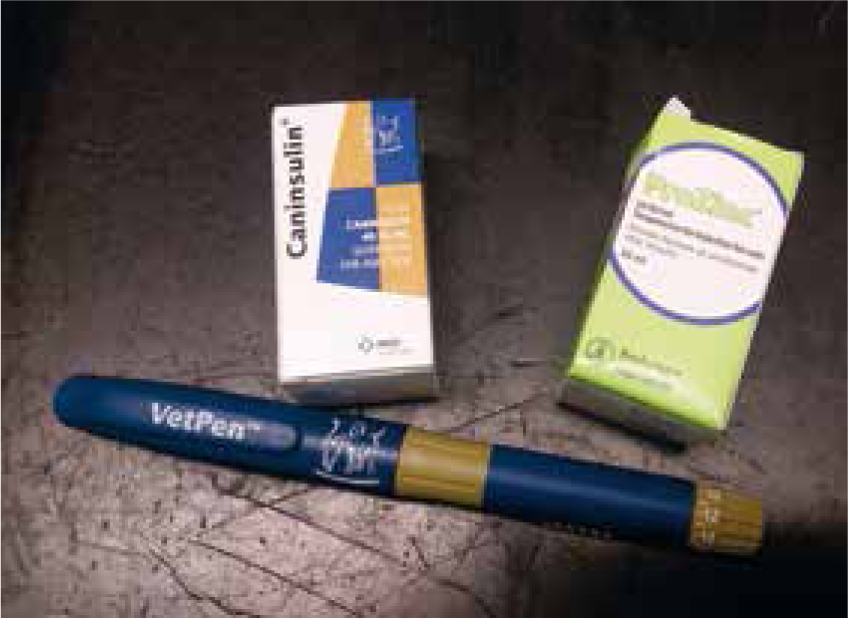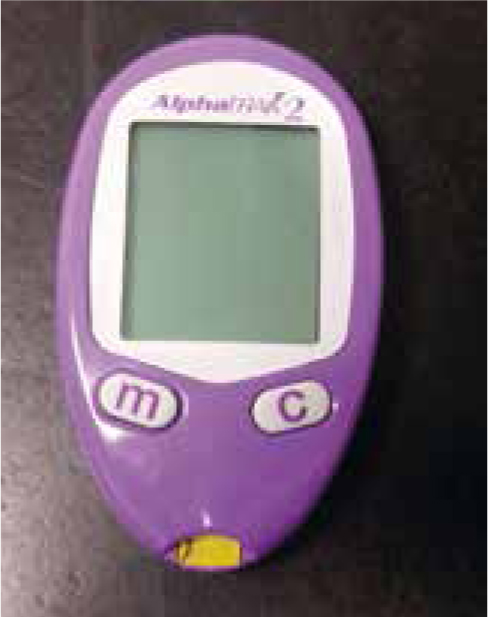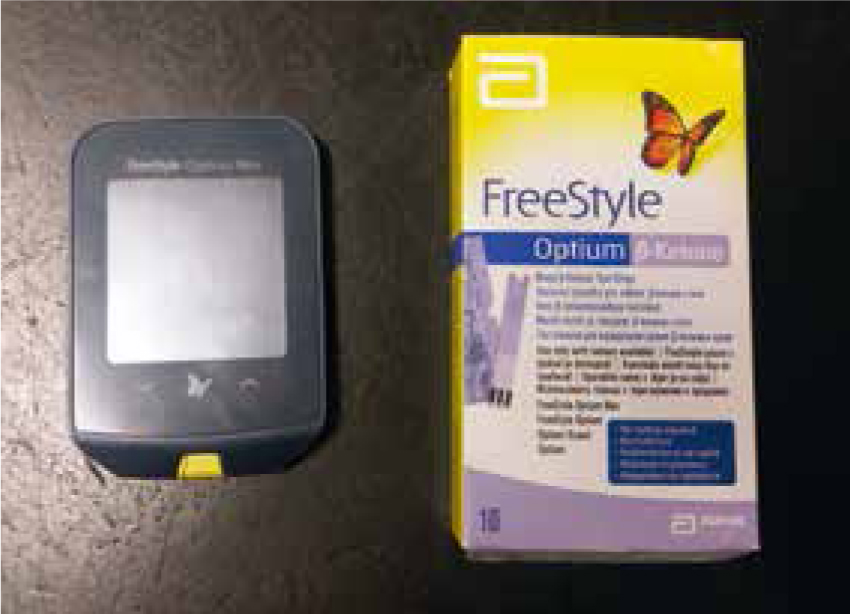Having a newly diagnosed diabetic pet can be an overwhelming time for owners. Having a good point of communication can be really helpful for an owner enabling them to convey any worries. Offering the opportunity for the owner to discuss difficulties should be advocated, with nurse clinics providing support and education. Having a named nurse that can act as this port of call, can help to put the client's mind at rest, and the nurse can answer any queries or questions they may have.
Diabetes protocols
Having a set practice protocol for the treatment of diabetic patients is an important first step. The ISFM consensus guidelines for diabetes protocol (Sparkes et al, 2015) and the MSD/UK-Vet guidelines (Ackerman et al, 2018) can aid the practice in creating their own protocol for treating their diabetic patients. This will need to include what insulins to start the pet on (Fiure 1), dosage guidelines, dietary guidelines, frequency of re-examinations etc. These will need to be decided on by the whole veterinary professional team. It is an ideal opportunity to use evidence-based medicine and reflective practice in designing the protocol.

The diabetic clinic
Ideally all owners of newly diagnosed animals (with any medical condition) should be offered the opportunity to discuss matters with a registered veterinary nurse (RVN) in a nurse-led clinic. Discussions may include administration of medication, questions about the disease process, nutrition, exercise, pain scoring, e.g. Helsinki chronic pain index (Hielm-Bjorkman et al, 2009) and quality of life (QOL) assessment, e.g. HHHHHMM Scale (Villalobos, 2007).
In the case of diabetes many practices will admit the animal on the first day of insulin therapy, in order to monitor response. Clients will need to be taught many different elements as described in Table 1, before the discharge of their pet. This can be done at the time of discharge, or earlier in the day, or even in the preceding days in a number of sessions in order to convey the information in less of a bolus fashion. In most cases covering all these elements in a one-off session can take 30–45 minutes.
| Minimum to be covered |
|---|
| Ensure owner understands disease process and treatment, that there is an unknown period of time taken to reach stabilisation or possibly remission in cats |
| Discuss storage of insulin |
| Administration of insulin (syringes and needles or VetPens) |
| Timings of administration of insulin |
| Disposal of sharps |
| Feeding (timings of food, frequency, types of foods to feed) |
| Exercise (quantity and quality) |
| Home monitoring (glucometers, water consumption, general demeanour) — use of a diary |
| What to do in an emergency (who to contact) |
Some clients will need more help than others. Offering the opportunity for the owner to have help on hand when they start with injections, can help reduce anxiety. Clients can be offered a nurse appointment twice daily at the time of injections until they are happy with the process.
How frequently the animal is seen again is will depend on the veterinary surgeon (VS) in charge of the case and the animal's response. Follow-up clinics with the nurse will normally include a range of different elements which will vary from practice to practice and be dependent on the equipment available (Table 2).
| Minimum requirements |
| Any repeat blood samples, including fructosamine, whether in-house or reference laboratory |
| Nutritional assessment (weight, body condition score, muscle condition score) |
| Discuss about how the owner is getting on — trouble shooting any issues |
| Urinalysis |
| Dependent on equipment |
| Blood pressure measurement |
| Other elements |
| Chronic pain scoring (an important aspect in arthritic patients) |
| Quality of life assessment (can prove to be useful long term) |
Diagnostics in diabetes clinics
Within the diabetes clinics there is a requirement for diagnostics to be conducted. These will be dictated by the VS in charge of the case, but can be delegated to the RVN (RCVS, 2012). Blood sampling is a Schedule 3 task, so as long as competency has been shown the VS can delegate the task. For good utilisation of staff, blood sampling is a task that should be done by RVNs.
Other sampling techniques such as urinalysis, blood pressure measurement and use of glucometers can all be undertaken in nurse clinics (Figures 2 and 3). The nurse is ideally placed to perform all of these techniques, to gather all of the information required by the VS, in order for them to determine the course of treatment for the animal.


Nutrition for diabetic patients
The nutritional recommendations for diabetic cats differs greatly from diabetic dogs. This also includes the feeding frequency. Cats should be fed a low carbohydrate high protein diet, e.g. some diets have 50% protein on dry matter base (DMB), fat 21% and carbohydrate 16%, fed free choice through out the day. Free choice is having a set amount each day, but the cat can access the food whenever it wants. Meal feeding is preferred in dogs, feeding a complete balanced diet that is low in simple sugars, e.g. 16% fibre on DMB in diabetic canine diets compared with 2–5% in lifestage diets. Many diets do not state the volume of simple sugars as part of the carbohydrate levels, but in some veterinary diabetic diets the simple sugar level is less than 2% DMB, no semi-moist element and of a closed formulation (Table 3). The price of a diet does not always dictate quality, there are many expensive pet foods, that are termed ’boutique pet foods’ that are no better than cheaper brands. Good investigation of the food by examining the pet food label and questioning the manufacturers, and understanding the evidence behind each diet is recommended.
| Open formulation | Advantages | Disadvantages |
| Same recipe is used each time to make the diet | Can be cheaper in price | Each batch produced can be slightly different |
| Ingredients might be less defined, meat rather than chicken | ||
| Ingredients sourced differently each time | ||
| Closed formulation | Advantages | Disadvantages |
| Same recipe is used each time to make the diet | Each batch produced will be similar | Can be more expensive |
| Ingredient will be more defined | ||
| Ingredients sourced from defined suppliers, potentially same farm |
Nutritional assessments are a very important aspect of the nurse clinic. Performing the nutritional assessment will enable you to determine the feeding quantities for the animal.
Communication
There is no definitive answer to the best forms of communication, it will vary depending on the situation, the client and the information that is being imparted. A good communicator can adapt how they communicate depending on these factors. This is an important element of all nurse consultations, not just diabetes clinics.
Clinic nurses will use discussion, but will also have other forms of communication, such as leaflets, handouts, website addresses. Bullet pointing key points (medications, feeding quantities) for the client can be helpful, these can be emailed to the client so that they can refer back to them if needed.
Conclusion
RVNs are well equipped to provide an important service for clients that will dramatically improve the wellbeing and welfare of their diabetic pet. A diabetic nurse service or clinic should be advocated in all veterinary practices.

